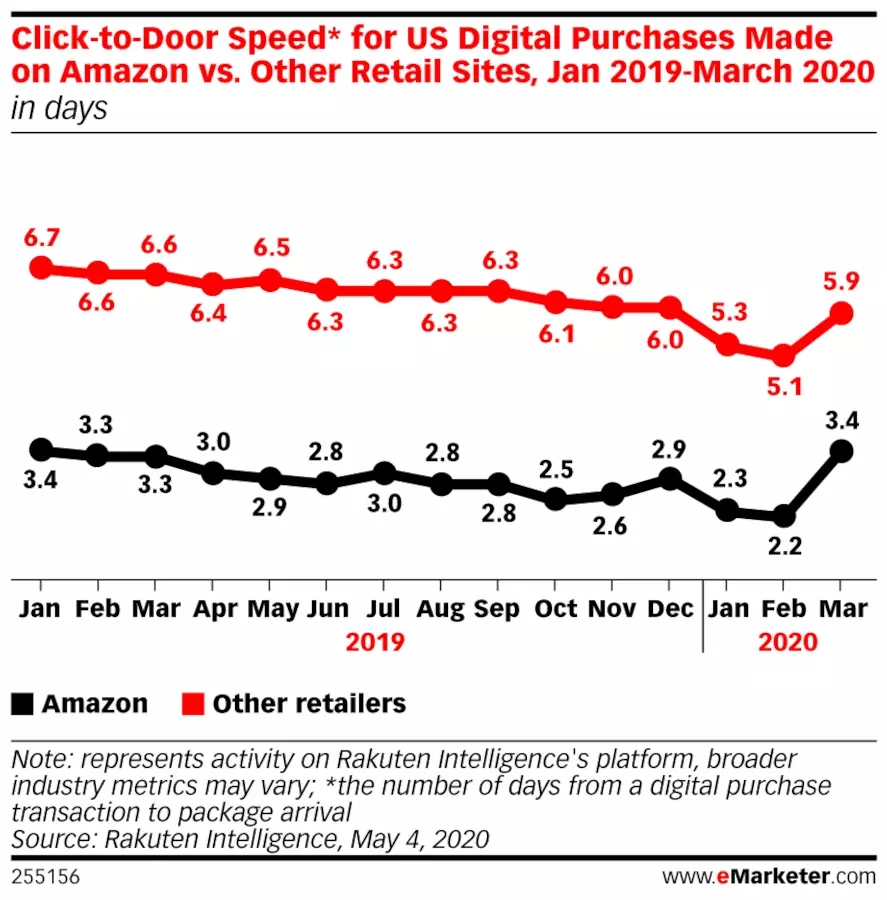Reading Time: 17 Minutes
Direct-to-consumer brands are the latest in agile, ecommerce retail. Because they enjoy lower production costs and access to a variety of affordable tech tools, DTC brands are well-positioned to set the pace for frictionless shopping in a post-COVID economy.
From click-to-collect to augmented reality fashion fitting and social commerce features, DTC brands are redefining retail in ways few would have imagined just a decade ago.

And thanks to the surge of online shopping (across generations), brands don’t need a Nike-sized budget to offer a meaningful omnichannel shopping experience.
In ecommerce, frictionless shopping means that customers can do more browsing and buying with fewer inconveniences along the way.
Frictionless shopping builds on a great product or service to provide a great shopping experience. Today, DTC brands can’t afford to have one without the other since the sheer volume of new online brands is growing fast.
“46% percent of consumers said they would pay more for a friendly and welcoming experience, and 55% said they’d pay more for a fast and efficient service.”
– Commbox
Thanks to the latest technology, it is increasingly possible to remove barriers that everyone previously thought were unavoidable.
To make online shopping truly seamless, customers must feel joy at the idea of visiting your store and relief knowing that doing business with your brand will be convenient and painless.
Forward-thinking retailers can identify inconveniences before consumers are even aware themselves. In fact, it’s only after a brand “hacks” an inconvenience that consumers realize what they’ve been missing.
For example, customers who used to accept 7-10 business day shipping now won’t give a brand the light of day if they can’t get their order in less than a week, thanks in large part to Amazon Prime’s two-day shipping guarantee.
Brands that find these ecommerce shortcuts do so only after gaining an in-depth knowledge of their customer pain points, goals, and aspirations. That’s why frictionless shopping is an ongoing improvement process in retail.
As such, DTC brands often don’t have to “reinvent the wheel” when it comes to frictionless shopping. Among the most common points of friction in online retail are:
Because of how many brands consumers can choose from, an unknown brand is an untrusted brand.
Consumer distrust is perhaps the leading cause of friction in the shopping experience. Without customer reviews or a reliable online presence spread across multiple platforms, prospects fail to enter the customer funnel.
A major turn off for online shoppers is a drawn out “add to cart” and checkout process. Clicking through 5-7 different pages to complete a purchase was okay for ecommerce pre-2010, but in 2021, that is simply unacceptable.
Particularly for online stores that require users to create an account, buyers should not feel like they are bending over backwards to save items to a cart, navigate through multiple redirects, choose from a restricted list of payment options, or re-enter previously saved billing/shipping addresses.
Another point of friction for DTC brands is a website that is hard to understand and use. Shoppers should be able to find what they are looking for easily.
Website visitors will not want to buy from a website that lacks reliable search features, relevant product description pages, category menus, and a collection of easy-to-find customer assistance tools.
DTC brands that use ambiguous messaging or poorly-planned marketing strategies confuse their audiences. In some cases, brands target the wrong audience altogether.
It is easy for brands to lose touch with the consumer’s point of view. When this happens, the brand might mean to say one thing but communicate something entirely different.
Extending your online store onto other channels is great – unless those channels aren’t in sync. When you don’t have seamless integration among your various channels, shoppers can’t count on your brand to keep up with inventory, provide up-to-date order information, or save lists they’ve created on one of your channels.

Unless you are shipping internationally or across an ocean, most online shoppers will balk at the idea of having to wait a week or longer for their order.
As a disclaimer, most shoppers don’t mind having the option for longer, cheaper shipping. But many ecommerce websites still don’t give customers the option for faster shipping, to include overnight or rushed.
A common pain point for shoppers when buying online is the risk of getting the wrong size, color, flavor, etc. This pain point swells when that customer finds out the hard way that the return process is costly or challenging.
Offering a simple, expedited return/exchange process is one of the most overlooked ways that DTC brands can remove obstacles for their shoppers.
“Ecommerce personalization is a set of tools and strategies that deliver a constantly updated and user-centric online shopping experience.”
– GRIN, Top 5 Ways to Personalize Your Customer’s Shopping Experience for Ecommerce
Brands that treat their products and services as “one size fits all” are liable to fail unless they offer rock-bottom prices. But even when marketing the lowest price possible, many consumers still opt for a more personalized experience.
Personalization can include simple product suggestions, such as those based on past purchases or searches. It can also include intuitive features, like AR fitting rooms and customer preference surveys followed by tailored recommendations.
“We’re seeing a huge range of influencers who just want to do these amazing, very candid, very honest videos, and then be able to put people in touch with those products immediately.”
– Rayhan Perera, GRIN Gets Real Podcast
When few consumers know that you exist, you can accomplish more with less by partnering with influential customers, to include loyal fans and social media influencers. These individuals will not only give you invaluable user-generated content, but they will also provide your brand with powerful social proof to boost awareness and sales.
“Genuine trust is the only fix. Direct relationships inspire honest endorsement.”
– GRIN, Authentic Influencer Marketing
This goal is difficult to achieve without shoppers creating an online profile on your website, but any steps you take to reduce the number of clicks for customers to complete their purchase, the better.
In-app shopping on Facebook, Instagram, and TikTok all come with the functionality to help users buy in just a few clicks. Using these social commerce tools allows you to offer a better user experience while you collect the resources you need to improve your site’s checkout process.
UX design is the process of making your website more welcoming, intuitive, and personalized. Many ecommerce platforms like Shopify come with a few customizable UX design features.

For a more in-depth frictionless shopping experience, you might want to consult a UX/UI design expert or agency.
“There’s been a shift in consumer attitudes over the last few years, which is that people are over the B.S. And we’ve hit a tipping point where suddenly those brands [who are] actually authentic, and that are human, and that are just coming at you as they are, it’s actually pretty refreshing. And it’s led to those brands growing faster. “
– Matt Barnett, GRIN Gets Real Podcast
Authenticity is more than “feel good” marketing. When consumers see a genuine effort from a brand that shares their values, solves their problems, and makes them feel empowered to achieve their goals, that brand’s marketing resonates in a way that is difficult for competitors to imitate.
When you create authentic content, you increase the effectiveness of your organic reach (website, social media, etc.), boost brand loyalty, and decrease your customer acquisition costs.
An omnichannel retail strategy used to be an approach for brands with brick-and-mortar storefronts and enterprise budgets. But thanks to the explosion in ecommerce over the last few years, a growing number of shoppers are finding a 360 shopping experience online.
If your DTC brand uses more than one platform – website, mobile app, pop-up shops, social commerce, etc. – the steps you take to integrate these channels contribute to an omnichannel marketing and sales success.
Users can visit your store on any medium and get essentially the same, amazing experience, complete with profile data, wish lists, and saved payment methods.
It’s hard to beat Amazon’s two-day shipping without becoming a Prime Seller. But if you see ways to expedite your fulfillment and shipping process, you can reduce order wait times enough to delight your customers.

Image via eMarketer
Some DTC brands focus their efforts on specific regions where they know they can achieve faster shipping. Ecommerce localization tactics allow you to invest resources to dominate a geographical area and expand as the brand gains more distribution capabilities.
On the same note, offering free shipping and including expedited shipping at a price is a legitimate frictionless shopping approach that can further endear customers to your brand.
No DTC brand enjoys managing returns and exchanges. But the reality is that it is nearly impossible to nurture brand loyalty without a streamlined return/exchange process.
When customers know that they can return or exchange products with modest effort, they will feel more confident in making future purchases with your brand. Advertising a smooth return process can also encourage new customers to make their first purchase sooner.
“Personalization is a balance between automation technology and a marketer’s emotional intelligence.”
– GRIN, Top 5 Ways to Personalize Your Customer’s Shopping Experience for Ecommerce
If you go the extra mile to identify your ideal customer, connect with them, and then welcome their feedback, there is literally no limit to your brand’s personalization potential.
Before you personalize, you must be set up to manage long-term relationships with your customers. Incidentally, your customer relationships also create a solid foundation for discovering new frictionless shopping opportunities now and in the future.
There is literally nothing more important in retail than the brand-consumer connection.
Digital shopping allows consumers to choose from many brands for a single product. The world has evolved beyond scarcity to a place where quality, personalization, and authenticity become critical factors that impact a customer’s buying decision.
The more you invest in knowing and engaging your customer, the greater your ROI will be. To achieve a frictionless shopping experience, your DTC brand must become truly customer-centric.
And once you’ve mastered making your customer king, you’ll have earned their trust, loyalty, and viral word-of-mouth.
Stop wondering whether your brand is making an impact with customers online. Manage influential customer relationships in just a few clicks with GRIN today.
Learn more about influencer marketing: Influencer Marketing 101
Our team keeps a finger on the pulse, so you’re always working with the latest information.